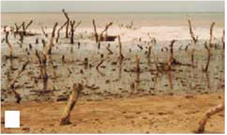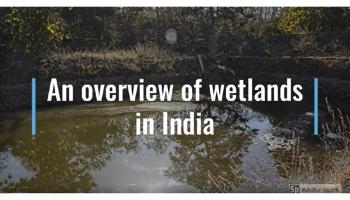/topics/lakes-ponds-and-wetlands
Lakes, Ponds and Wetlands
Discussion forum news !
Posted on 11 Sep, 2008 10:27 PMA very interesting thread has been initiated on the Discussion Forum on the Portal by Bob Eibl.
Drying of Lake Faguibine, Mali:Report by UNEP
Posted on 14 Aug, 2008 09:30 AMHome to more than 13 million people, Mali stretches from the Sahara Desert in the north to the semiarid grassland known as the Sahel in the south.
KRAPAVIS:Reviving "Orans" physically and conceptually
Posted on 13 Aug, 2008 04:39 AMOrans are local micro bio-diversity reserves- community conserved areas (CCAs) harboring the shrine of a local goddess or deity. Also known as Dev-banis, these local forests vary in size from a hundred to five hundred bighas (about hundred hectares). Most Orans have sources of water, either small springs or rivulets running through them or a variety of ponds and nadis in their midst.
Anupam Mishra's books on water - Aaj Bhi Khare Hain Talaab & Rajasthan Ki Rajat Boondein
Posted on 20 Jun, 2008 06:40 AMShri Anupam Mishra, Gandhian and environmentalist is a remarkable person. He lays no claim to copyright for his own books and (similiar to open source software) it has increased the dissemination of his message. During a recent visit to his office at Gandhi Peace Foundation in New Delhi, he showed several different editions of "Aaj Bhi Khare Hai Talaab" brought out by all kinds of individuals and publishers across the country. He recounts the story of how a impoverished young person was inspired to translate it into Punjabi and get it published.
Environmental flows for Indian rivers:Need for a discussion to consider the health of the riverine ecosystems
Posted on 24 Apr, 2008 11:58 PMIndia is facing a water crisis in nearly all the sectors. Fortunately or unfortunately, measures taken by the related authorities to combat the crisis often depends on the amount of 'noise' made by the relevant stakeholders. It is no wonder then, that the urban India, and especially the rich and the powerful in urban India, seldom have to face problems related to water scarcity, water quality or the sheer inequity in distribution. On the other hand, weaker the stakeholder, more severe are his ( rather 'her') problems. Marginal farmers, tail enders in a canal network, rural and urban poor, especially children and women, stand testimony to this situation. We all agree to this, right? 
Godavari delta, destruction of mangroves
But aren't we forgetting the the weakest, and in some ways, the strongest, of all the stakeholders? How about the ecosystem of the river itself??
Cloud seeding for increasing rainfall
Posted on 16 Nov, 2007 08:18 PMDue to the heat from the Sun the water in the rivers, lakes and Oceans becomes water vapour. As this hot moist air rises into the sky the temperature gets reduced at 7oC per km height in the sky.









